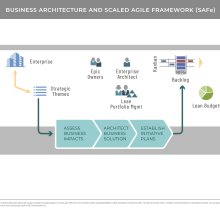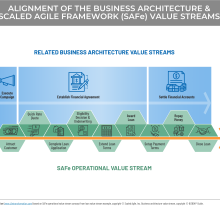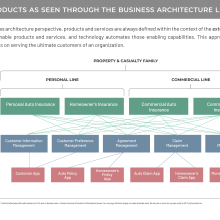Organizations around the world have been adopting the Scaled Agile Framework (SAFe). This has provided many benefits to organizations, but also opened up some new questions on how business architecture fits within the framework and how it can bring value to the process.
So, we brought in a guest star for this special installment of StraightTalk to answer your top Frequently Asked Questions (FAQs) about business architecture and SAFe. Jo Gilmore is a rare individual who is deeply experienced in both business architecture and SAFe, as well as how to bring them together successfully. Jo is a marketing manager with over 20 years of experience in Product Development, Portfolio Strategy, and Marketing. She is a Certified Business Architect® and started the Marketing Business Architecture practice for FedEx. She is also certified as a SAFe (Scaled Agile Framework) Program Consultant and for Lean Portfolio Management (LPM), and practices and teaches both SAFe and general Agile concepts.
So here we go with 10 FAQs on business architecture and SAFe, answered by Jo, in classic, right-to-the-point StraightTalk style.
Disclaimer: we’ve made some tiny adjustments for our typical StraightTalk-style: the blue headings represent StraightTalk asking the questions and our guest, Jo, responds in turn. Make sure to check out Jo’s brilliant podcast firsthand in 10 Minutes With Jo Gilmore: 10 Frequently Asked Questions About Business Architecture and SAFe. It’s 10 minutes you’ll be glad you invested.
FAQ #1: Where does business architecture fit within the SAFe framework?
Jo: “The most common place that you find business architecture is in the enterprise and portfolio layer, really on the front end of it as an input to the portfolio backlog – but you can apply it at lower levels as well.”
P.S. Here’s a quick view of that to help you visualize it.
FAQ #2 (a million-dollar question): What unique value does business architecture bring to SAFe?
Jo: “The idea with scaled agile is to put just enough resources into the analysis at any given stage to determine whether you want to continue to invest or stop the work so that you aren’t overcommitting. Business architecture lets you very quickly identify where the business and its capabilities will be impacted, which also helps us understand who needs to be involved in the next level of analysis.
Business architecture can also give you a glimpse into the complexity that will be required at the next level because you have a sense of how mature those capabilities will be.”
FAQ #3: What is the difference between SAFe value streams and business architecture value streams?
Jo: “SAFe has two kinds of value streams within their construct:
- Operational value streams that are more aligned to business architecture value streams
- Development value streams that are probably better aligned to what we would look at as groupings of business architecture capabilities
In my opinion, business architecture provides much better definition and consistency of value streams where there is more structure around them including the inputs, outputs, and drivers of each stage, which can inform operational value streams and allow them to be more effectively managed.”
BTW, here’s an example of how business architecture value streams would align with a SAFe operational value stream. In this case, we see multiple business architecture value streams align because there are multiple, concrete packages of value being delivered to different stakeholders where the SAFe value stream is more of an end-to-end life cycle.
FAQ #4: Can organizations use business architecture value streams in place of SAFe operational value streams, or do they need to define both and align them?
Jo: “It depends. To a large extent, it’s a function of the size of an organization. For example, for FedEx, Send Shipment, which is one of our core value streams, is just too large to manage feasibly within our SAFe execution. So, we had to break it down a little bit in order to create measurable and viable operational value streams that we can look at.
But, for other organizations, you may actually find that the operational value stream and business architecture value stream are really similar and give you a lot of concrete framework to work from. For sure the business architecture value streams should be a starting point.”
FAQ #5: Where do capabilities come in and how are they used?
Jo: “Capabilities can start to tell you what parts of the organization are going to be impacted, and they can also give you some sense of complexity or size of the effort. At FedEx we use capabilities right from the beginning to make sure that we can bring in the right participants to shape the work as well as to identify whether we have the capabilities in place to support the business ask. This gives us some sense of the tradeoff between cost and value and whether or not we’re investing in the right things.
FAQ #6: How is the term product used in SAFe versus in business architecture?
Jo: “I think one of the benefits of business architecture is the specificity of its definitions. In business architecture, the term product has a very specific meaning and is customer-facing. In SAFe, the term product is mostly used to describe a capability or a system grouping once you get below the portfolio level. You may hear some reference to product in the traditional sense at the upper level, but in the execution levels they are talking about capabilities or systems.”
P.S. Here’s a quick snapshot of how we view products through the business architecture lens, from the customer-facing perspective as Jo mentioned. You can read more in Post No. 63 as well.
FAQ #7: How can business architecture value streams, capabilities or other perspectives be used to help scope and define Agile Release Trains or at a lower-level epics, features or user stories?
Jo: “I think capabilities are a really good way to think about how to construct an Agile Release Train (ART). A capability is reusable and repeatable, and therefore it is sustainable in a way that an ART needs to be. Centering a train around one capability or multiple capabilities that work together is a great way to ensure that there is always a pipeline of work, a common body of knowledge developed, and that the individual business asks are integrated with the maturity of the development of the capabilities themselves. You get that matrixed view.
It also helps you to put the capability within the context of the value stream because now you can look at how a capability impacts upstream and downstream activities so that you get a more holistic view.”
FAQ #8 (another million-dollar question): What does a product manager do in SAFe versus a product owner – and how should business architects work with these product roles?
Jo: “I’ll start from the bottom up. A product owner works directly with a single team and has a single focus, ensuring that the team produces workable code every iteration that delivers against the backlog. They are tightly focused.
A product manager does a similar role but with a broader lens. They look across multiple teams to make sure that the work comes together to deliver more integrated results – often one that is more releasable to an external customer.
Business architects should be providing guidance on how to align outcomes across capabilities and value streams in order to reduce the risk of duplication of effort or to provide additional value to those capabilities. So, it is probably most effective for business architects to work with product managers versus product owners, but they should be available to product owners to provide context.”
FAQ #9: What advice do you have for business architecture leaders and practitioners who are trying to get involved with SAFe in their organizations – what’s the best way to start engaging?
Jo: “Just start somewhere. Find someone who is working in that space and make a connection with them. Find out what their needs are and try to see how what you do and what you know can help their efforts.
A lot of times, SAFe starts within the IT organization and of course enterprise architects tend to be heavily engaged, so aligning with them is key. In addition, there is usually one or two business units or departments that are faster adopters and out ahead. Focus on understanding the business architecture around their space can help you support their efforts and add value very quickly.”
FAQ #10: What is your #1 tip for organizations to be successful in leveraging business architecture and SAFe together?
Jo: “To be successful at putting those two things together – but also in driving any large change like this – solve a problem for someone. Find someone who is struggling to get something done and help make their life easier by showing them how putting these two things together isn’t just a theory – it really is a practical way to enhance SAFe.
For example, at FedEx, we knew that within our product development environment we had a lot of pain and a lot of churn in projects. We would get into the projects and find out that we hadn’t foreseen some of the obstacles from an architectural perspective because we didn’t have a good view into that space holistically and we didn’t know who owned what pieces of it. By implementing business architecture and putting it together with the SAFe framework where we did more upfront analysis, we were really able to predict where those obstacles were going to be and start preparing for them.”
More Good Stuff...
10-Minutes With Jo Gilmore: 10 Frequently Asked Questions About Business Architecture and SAFe (StraightTalk podcast): Just in case you missed that link right there in the beginning, make sure to check out Jo’s amazing podcast, which was the basis for this post.
5-Minutes With Alex Randell: The Relationship Between Business Architecture and Agile (StraightTalk podcast): More straight talk by another superstar in this space. See also the related StraightTalk Post No. 27.
Business Architecture + SAFe Presentations: Learn from your friends. Check out these excellent presentations from previous Guild Business Architecture Innovation Summits.
- Business Architecture: Accelerating Scaled Agile and Value Delivery (Rob Kuchinski at the March 2019 Guild Business Architecture Innovation Summit)
- From Strategy to Solution Using SAFe: Standing up an Integrated Architecture (Cari Brose and Jeff Green at the March 2017 Business Architecture Innovation Summit)
Guiding Portfolio Investments With LPM and Business Architecture (Jo Gilmore and Bill Garland at Business Agility Memphis): A great presentation on a related topic.
Business Architecture: The Gateway to Transforming an Organization Into an Agile Enterprise (Kuehn and Ulrich): A white paper by business architecture industry leaders Whynde Kuehn and William Ulrich that illustrates how business architecture can be a gateway for an organization to transform itself into an agile enterprise.
Aligning Business Architecture and the Scaled Agile Framework® (Business Architecture Guild® White Paper): A Guild white paper that reconciles the terms value stream and capability between business architecture and SAFe. (See Business Architecture Guild® Public Resources page.)
Business Architecture and SAFe-Related Recorded Webinars (Business Architecture Guild®): Here are some webinars on the topic: Aligning Product Concepts in Agile Execution With Business Architecture, From Strategy to Agile Stories: An Epic Journey, and Business Architecture in the Scaled Agile Framework. (Requires Guild membership.)
What is SAFe? (CIO): A brief overview if you are new to the topic.
Product Vision, Agile, and Going to the Moon (Lorenzo Pasqualis): An engaging and valid perspective on the importance of clear product vision in balance with the building of it.
7 Ways to Sabotage Your Shift to Agile (CIO): What not to do with Agile. Some good reminders here.
Agile Business Transformation: What It Takes to Succeed (TED Talk): A very interesting TED Talk where Joe Justice speaks with Phil Klein about how people and management are embracing, resisting, and implementing the culture side of change towards agile. (Note: There is an abrupt ending, but it’s a valuable dialogue regardless.)



